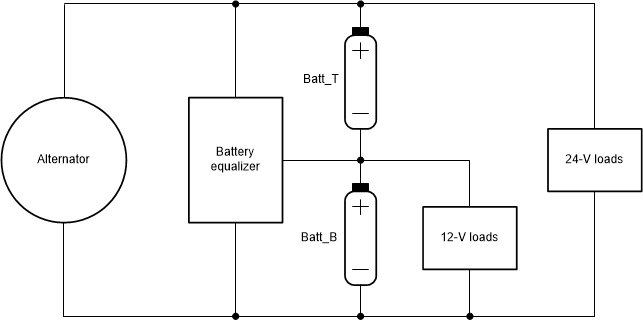SNVAA30 December 2021 LM5170-Q1
1.1 Commercial Vehicle Power System
Commercial vehicles usually adopt two 12-V automotive batteries in series to produce the needed 24-V supply rail. Figure 1-1 shows the typical architecture of commercial vehicle power system. Alternator charges the two 12-V batteries placed in series. The stacked 24-V voltage supports the 24-V electronics (or 24-V loads hereafter), while the bottom battery, namely Batt_B, supplies 12-V electronics in the vehicle. Such architecture allows the commercial vehicles to reuse the low cost 12-V electronics (or 12-V loads hereafter) developed for passenger cars, therefore reducing the overall electronic cost of the commercial vehicle.
In this architecture, the battery equalizer is necessary. Without the battery equalizer, Batt_B can be consumed faster than the top battery, namely Batt_T, which would become over-charged and Batt_B under-charged. The over-charge would degrade the lifetime of Batt_T, and the undercharge of Batt_B would lose sufficient supply voltage for the 12-V loads. Consequently, the overall system lifespan as well as performance will be adversely affected.
 Figure 1-1 Power System of Commercial Vehicles
Figure 1-1 Power System of Commercial VehiclesBy introducing the battery equalizer, both Batt_T and Batt_B can stay well-balanced, resulting in maximal battery life time as well as improved system performance. In this report, a buck converter design based on the LM5170-Q1 controller is presented to implement the battery equalizer.